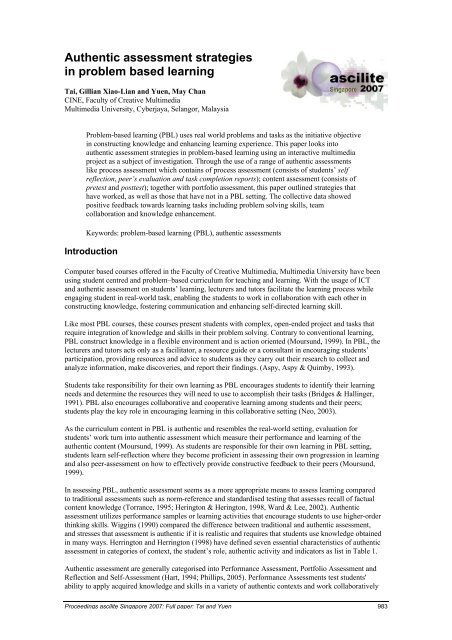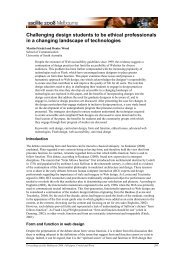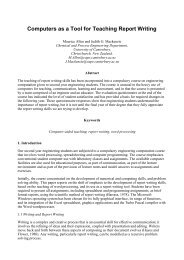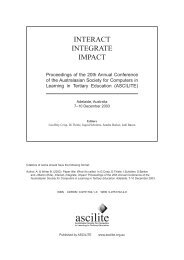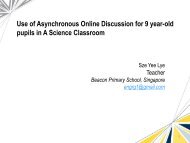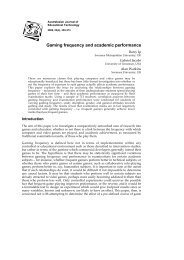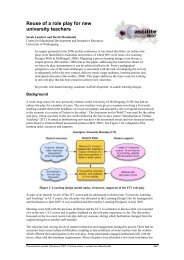Authentic assessment strategies in problem based learning - ascilite
Authentic assessment strategies in problem based learning - ascilite
Authentic assessment strategies in problem based learning - ascilite
Create successful ePaper yourself
Turn your PDF publications into a flip-book with our unique Google optimized e-Paper software.
<strong>Authentic</strong> <strong>assessment</strong> <strong>strategies</strong><br />
<strong>in</strong> <strong>problem</strong> <strong>based</strong> learn<strong>in</strong>g<br />
Tai, Gillian Xiao-Lian and Yuen, May Chan<br />
CINE, Faculty of Creative Multimedia<br />
Multimedia University, Cyberjaya, Selangor, Malaysia<br />
Problem-<strong>based</strong> learn<strong>in</strong>g (PBL) uses real world <strong>problem</strong>s and tasks as the <strong>in</strong>itiative objective<br />
<strong>in</strong> construct<strong>in</strong>g knowledge and enhanc<strong>in</strong>g learn<strong>in</strong>g experience. This paper looks <strong>in</strong>to<br />
authentic <strong>assessment</strong> <strong>strategies</strong> <strong>in</strong> <strong>problem</strong>-<strong>based</strong> learn<strong>in</strong>g us<strong>in</strong>g an <strong>in</strong>teractive multimedia<br />
project as a subject of <strong>in</strong>vestigation. Through the use of a range of authentic <strong>assessment</strong>s<br />
like process <strong>assessment</strong> which conta<strong>in</strong>s of process <strong>assessment</strong> (consists of students’ self<br />
reflection, peer’s evaluation and task completion reports); content <strong>assessment</strong> (consists of<br />
pretest and posttest); together with portfolio <strong>assessment</strong>, this paper outl<strong>in</strong>ed <strong>strategies</strong> that<br />
have worked, as well as those that have not <strong>in</strong> a PBL sett<strong>in</strong>g. The collective data showed<br />
positive feedback towards learn<strong>in</strong>g tasks <strong>in</strong>clud<strong>in</strong>g <strong>problem</strong> solv<strong>in</strong>g skills, team<br />
collaboration and knowledge enhancement.<br />
Keywords: <strong>problem</strong>-<strong>based</strong> learn<strong>in</strong>g (PBL), authentic <strong>assessment</strong>s<br />
Introduction<br />
Computer <strong>based</strong> courses offered <strong>in</strong> the Faculty of Creative Multimedia, Multimedia University have been<br />
us<strong>in</strong>g student centred and <strong>problem</strong>–<strong>based</strong> curriculum for teach<strong>in</strong>g and learn<strong>in</strong>g. With the usage of ICT<br />
and authentic <strong>assessment</strong> on students’ learn<strong>in</strong>g, lecturers and tutors facilitate the learn<strong>in</strong>g process while<br />
engag<strong>in</strong>g student <strong>in</strong> real-world task, enabl<strong>in</strong>g the students to work <strong>in</strong> collaboration with each other <strong>in</strong><br />
construct<strong>in</strong>g knowledge, foster<strong>in</strong>g communication and enhanc<strong>in</strong>g self-directed learn<strong>in</strong>g skill.<br />
Like most PBL courses, these courses present students with complex, open-ended project and tasks that<br />
require <strong>in</strong>tegration of knowledge and skills <strong>in</strong> their <strong>problem</strong> solv<strong>in</strong>g. Contrary to conventional learn<strong>in</strong>g,<br />
PBL construct knowledge <strong>in</strong> a flexible environment and is action oriented (Moursund, 1999). In PBL, the<br />
lecturers and tutors acts only as a facilitator, a resource guide or a consultant <strong>in</strong> encourag<strong>in</strong>g students’<br />
participation, provid<strong>in</strong>g resources and advice to students as they carry out their research to collect and<br />
analyze <strong>in</strong>formation, make discoveries, and report their f<strong>in</strong>d<strong>in</strong>gs. (Aspy, Aspy & Quimby, 1993).<br />
Students take responsibility for their own learn<strong>in</strong>g as PBL encourages students to identify their learn<strong>in</strong>g<br />
needs and determ<strong>in</strong>e the resources they will need to use to accomplish their tasks (Bridges & Hall<strong>in</strong>ger,<br />
1991). PBL also encourages collaborative and cooperative learn<strong>in</strong>g among students and their peers;<br />
students play the key role <strong>in</strong> encourag<strong>in</strong>g learn<strong>in</strong>g <strong>in</strong> this collaborative sett<strong>in</strong>g (Neo, 2003).<br />
As the curriculum content <strong>in</strong> PBL is authentic and resembles the real-world sett<strong>in</strong>g, evaluation for<br />
students’ work turn <strong>in</strong>to authentic <strong>assessment</strong> which measure their performance and learn<strong>in</strong>g of the<br />
authentic content (Moursund, 1999). As students are responsible for their own learn<strong>in</strong>g <strong>in</strong> PBL sett<strong>in</strong>g,<br />
students learn self-reflection where they become proficient <strong>in</strong> assess<strong>in</strong>g their own progression <strong>in</strong> learn<strong>in</strong>g<br />
and also peer-<strong>assessment</strong> on how to effectively provide constructive feedback to their peers (Moursund,<br />
1999).<br />
In assess<strong>in</strong>g PBL, authentic <strong>assessment</strong> seems as a more appropriate means to assess learn<strong>in</strong>g compared<br />
to traditional <strong>assessment</strong>s such as norm-reference and standardised test<strong>in</strong>g that assesses recall of factual<br />
content knowledge (Torrance, 1995; Her<strong>in</strong>gton & Her<strong>in</strong>gton, 1998, Ward & Lee, 2002). <strong>Authentic</strong><br />
<strong>assessment</strong> utilizes performance samples or learn<strong>in</strong>g activities that encourage students to use higher-order<br />
th<strong>in</strong>k<strong>in</strong>g skills. Wigg<strong>in</strong>s (1990) compared the difference between traditional and authentic <strong>assessment</strong>,<br />
and stresses that <strong>assessment</strong> is authentic if it is realistic and requires that students use knowledge obta<strong>in</strong>ed<br />
<strong>in</strong> many ways. Herr<strong>in</strong>gton and Herr<strong>in</strong>gton (1998) have def<strong>in</strong>ed seven essential characteristics of authentic<br />
<strong>assessment</strong> <strong>in</strong> categories of context, the student’s role, authentic activity and <strong>in</strong>dicators as list <strong>in</strong> Table 1.<br />
<strong>Authentic</strong> <strong>assessment</strong> are generally categorised <strong>in</strong>to Performance Assessment, Portfolio Assessment and<br />
Reflection and Self-Assessment (Hart, 1994; Phillips, 2005). Performance Assessments test students'<br />
ability to apply acquired knowledge and skills <strong>in</strong> a variety of authentic contexts and work collaboratively<br />
Proceed<strong>in</strong>gs <strong>ascilite</strong> S<strong>in</strong>gapore 2007: Full paper: Tai and Yuen 983
to solve complex <strong>problem</strong>s. Portfolio Assessment <strong>in</strong>volves develop<strong>in</strong>g a portfolio that documents learn<strong>in</strong>g<br />
over time which <strong>in</strong> this study <strong>in</strong>clude and not limited to: journal entries; peer reviews; artwork, diagrams,<br />
charts, graphs; multimedia presentation; group reports; student notes and outl<strong>in</strong>es; rough drafts and<br />
polished writ<strong>in</strong>g (Hart, 1994; Ward & Lee, 2002). Reflection and Self-Assessment requires students<br />
reflect and evaluate their own participation, learn<strong>in</strong>g progress, and products which are essential<br />
component of autonomous learn<strong>in</strong>g (Hart, 1994).<br />
Table 1: Herr<strong>in</strong>gton and Herr<strong>in</strong>gton’s (1998) essential elements of authentic <strong>assessment</strong><br />
Categories Criteria<br />
Context Requires fidelity of context to reflect the conditions under which the<br />
performance will occur<br />
(rather than contrived, artificial or de-contextualised conditions)<br />
Student’s role Requires students to be effective performers with acquired knowledge, and to<br />
craft polished,<br />
performances or products<br />
Requires significant student time and effort <strong>in</strong> collaboration with others<br />
<strong>Authentic</strong> activity Involves complex, ill structured challenges that require judgments, and a full<br />
array of tasks<br />
Requires the <strong>assessment</strong> to be seamlessly <strong>in</strong>tegrated with the activity<br />
Indicators Provides multiple <strong>in</strong>dicators of learn<strong>in</strong>g<br />
Achieves validity and reliability with appropriate criteria for scor<strong>in</strong>g varied<br />
products<br />
Design<strong>in</strong>g an authentic <strong>assessment</strong> strategy<br />
Glasgow (1996) categorizes <strong>assessment</strong> <strong>strategies</strong> <strong>in</strong>to three areas of content, process, and outcome.<br />
Content deals with the knowledge students acquire, while process focuses on the students’ ability to apply<br />
knowledge and skill <strong>in</strong> <strong>problem</strong>-solv<strong>in</strong>g. Outcome <strong>assessment</strong>s whereas <strong>in</strong>volve the products students<br />
design that shows their comb<strong>in</strong>ation of content and new applications of knowledge, <strong>in</strong> this case the<br />
creation of a multimedia application.<br />
The issue raised from PBL is to provide an authentic <strong>assessment</strong> strategy. This learn<strong>in</strong>g space requires<br />
support <strong>in</strong> collaboration and communication among the students as a medium to exchange ideas, conduct<br />
discussion and put hands together. Students research, document, do peer’s feedback, design, learn various<br />
author<strong>in</strong>g tools for acquir<strong>in</strong>g, manipulat<strong>in</strong>g, and communicat<strong>in</strong>g <strong>in</strong>formation <strong>in</strong> order to solve the<br />
<strong>problem</strong>s and challenges given to them.<br />
The scope of the study was conf<strong>in</strong>ed to 53 students (N=53) tak<strong>in</strong>g Interactive Multimedia course, from<br />
Multimedia University. These students were not equipped with design and multimedia knowledge as they<br />
came from management or <strong>in</strong>formation technology background. Content <strong>assessment</strong> (consists of pretest<br />
and posttest) were conducted to p<strong>in</strong> po<strong>in</strong>t the students’ knowledge ga<strong>in</strong> <strong>in</strong> design and multimedia theories.<br />
A total of 10% is given to both tests (5% to each test).<br />
Students then formed 11 teams (T1-T11) of four or five members (TM) of their desired choice. A Team<br />
Leader (TL) was elected from every team. Each team was to output a PC-<strong>based</strong> multimedia application<br />
demonstrat<strong>in</strong>g understand<strong>in</strong>g and apply<strong>in</strong>g knowledge of design theories and techniques learnt <strong>in</strong> the<br />
lectures with the theme “Malaysian Culture” with<strong>in</strong> a 14-week time frame. The content of the application<br />
was entirely the team’s decision. At this stage, the <strong>in</strong>structors clearly def<strong>in</strong>e the standards and<br />
expectations of the application outcome and briefed the students of the criteria <strong>in</strong> assess<strong>in</strong>g students’<br />
work. Throughout the <strong>assessment</strong> process, students were rem<strong>in</strong>ded aga<strong>in</strong> on the <strong>assessment</strong> criteria so not<br />
to lose focus. <strong>Authentic</strong> <strong>assessment</strong> is most successful when students know what the <strong>in</strong>structors expect.<br />
(Pearson Education Development Group, 2007)<br />
The challenges beh<strong>in</strong>d this project was not limited to deal with team members who have multiple<br />
abilities, varied learn<strong>in</strong>g styles, and diverse backgrounds, but also <strong>problem</strong> solv<strong>in</strong>g <strong>strategies</strong> at different<br />
stages of the design. The maximum project grade (60%) goes to f<strong>in</strong>al portfolio <strong>assessment</strong> base on the<br />
criteria set by the facilitator which <strong>in</strong>clude the delivery of the f<strong>in</strong>al work, functionality and <strong>in</strong>teractivity of<br />
the application, enterta<strong>in</strong>ment value, presentation skills and f<strong>in</strong>al submissions. This portfolio <strong>assessment</strong><br />
made way <strong>in</strong> determ<strong>in</strong><strong>in</strong>g the PBL outcomes.<br />
Proceed<strong>in</strong>gs <strong>ascilite</strong> S<strong>in</strong>gapore 2007: Full paper: Tai and Yuen 984
Process <strong>assessment</strong> which consists of self reflection and peer’s <strong>assessment</strong> was designed to track the PBL<br />
process. Two sets of <strong>assessment</strong> forms were structured separately for each TL and TMs. The ma<strong>in</strong><br />
objectives for these <strong>assessment</strong> activities were to determ<strong>in</strong>e the authentic learn<strong>in</strong>g experience, the<br />
prevail<strong>in</strong>g attitudes of students towards PBL and the students’ response to the ways this PBL would be<br />
support<strong>in</strong>g their learn<strong>in</strong>g process. A schedule with dates and times to collect the <strong>assessment</strong> forms was<br />
planned accord<strong>in</strong>gly to match the multimedia project’s program as George and Cowan (1999) found that a<br />
schedule or checklist will aid observation, focus attention, and lead the students to make records <strong>in</strong><br />
appropriate form, which can be readily and comparably summarized and analyzed. These <strong>assessment</strong>s<br />
activity were seen important as it determ<strong>in</strong>es the grades for team progress, team work and <strong>problem</strong><br />
solv<strong>in</strong>g skills. This process <strong>assessment</strong> contributed to 30% of the students’ total project marks.<br />
Process <strong>assessment</strong>: Self reflection reports<br />
Each TM was given a set of Self Reflection Report to fill up. These <strong>assessment</strong> forms were distributed to<br />
the students every alternate week to report their daily progress and development of the project. A column<br />
was prepared to allow TM to jot down <strong>problem</strong>s encountered dur<strong>in</strong>g the project execution so to highlight<br />
the issues dur<strong>in</strong>g group discussion. The self reflection report permitted students to produce evidence of<br />
their task accomplishments. The nature of this <strong>assessment</strong> activity engaged mean<strong>in</strong>gful and authentic<br />
<strong>problem</strong>s; it <strong>in</strong>volved students assum<strong>in</strong>g responsibility for self-evaluation, thus encourage a factual and<br />
honest <strong>assessment</strong> report.<br />
Subsequently, the <strong>assessment</strong> reports were compiled and submitted to their respective TL. Upon<br />
evaluation, TLs were to provide a status report for each task assigned e.g. “Task completed”, “Task on<br />
hold”, or “Task <strong>in</strong> progress”. The task status and the <strong>problem</strong> and solution columns highlighted were<br />
meant to br<strong>in</strong>g awareness to the TLs so to br<strong>in</strong>g up the matter dur<strong>in</strong>g their group discussion.<br />
Process <strong>assessment</strong>: Peer’s evaluation reports<br />
S<strong>in</strong>ce this project entirely relied on students’ self-exploration, the TLs were given the responsibility to<br />
monitor their TMs’ explorations and guide the direction of their <strong>in</strong>quiries. In the Peer’s evaluation reports,<br />
TLs oversaw their TM’s report and summarized their progress accord<strong>in</strong>g to their <strong>in</strong>dividual tasks. TLs<br />
submitted both the Peer’s Evaluation Report and the Self Reflection Report to the facilitator. This data<br />
collection activity (as illustrated <strong>in</strong> Figure 1) was repeated until the completion of the project.<br />
Figure 1: Data collection activity<br />
Process <strong>assessment</strong>: The task completion reports<br />
The Task Completion Report had the similar layout as Self Reflection Report except that students were to<br />
wrap up the f<strong>in</strong>al development of their projects and report the way they manage their rema<strong>in</strong><strong>in</strong>g delegated<br />
tasks <strong>in</strong> the f<strong>in</strong>al week. TLs were to ensure that every given task was completed as scheduled. This Task<br />
Completion Report and all the other reports were <strong>in</strong> l<strong>in</strong>e with Oliver and Herr<strong>in</strong>gton’s (2003) position that<br />
students’ feedbacks were primary quality <strong>in</strong>dicators to assess<strong>in</strong>g and monitor<strong>in</strong>g the teach<strong>in</strong>g and learn<strong>in</strong>g<br />
process.<br />
Overall observations<br />
The <strong>problem</strong>-<strong>based</strong> multimedia project started out with TMs negotiat<strong>in</strong>g tasks accord<strong>in</strong>g to their<br />
capabilities. Followed by TLs delegated tasks and planned out their team’s deadl<strong>in</strong>es and schedules. Data<br />
collection is divided <strong>in</strong>to three stages: the beg<strong>in</strong>n<strong>in</strong>g of the project, the middle of the project and the end<br />
of the project.<br />
Proceed<strong>in</strong>gs <strong>ascilite</strong> S<strong>in</strong>gapore 2007: Full paper: Tai and Yuen 985
The beg<strong>in</strong>n<strong>in</strong>g of the project<br />
It was reported that all TMs played their roles and attentively filled up the self reflection reports. T3 and<br />
T7 passionately bra<strong>in</strong>stormed ideas and concept for their topic; T1, T3, T5, T6, and T10 <strong>in</strong>dustriously<br />
gathered resources for their selected area; T4, T5, T7, T8, T9 and T11 thoroughly planned out the project<br />
goals, project milestones, software platforms, TM’s roles and responsibilities. Throughout the semester,<br />
responses obta<strong>in</strong>ed from all teams’ reports went on smoothly with full participation except for T2 and<br />
T11. This is due to lack of project commitments and communication <strong>in</strong> both teams together with<br />
negligence <strong>in</strong> TL to follow up with the <strong>assessment</strong> activity.<br />
In the meantime, TMs’ progress are monitored and reported to be <strong>in</strong> l<strong>in</strong>e with the planned schedules by<br />
other TLs. T3, T4, T11 were reported as be<strong>in</strong>g beh<strong>in</strong>d schedule due to the TLs’ high demands on the<br />
project. Quality control was strictly applied on members’ project output. However TMs will<strong>in</strong>gly<br />
sacrificed their time for resource gather<strong>in</strong>g and redo<strong>in</strong>g unsatisfied output.<br />
The middle of the project<br />
Majority of the teams were function<strong>in</strong>g well, some teams reported enjoyment work<strong>in</strong>g on this project. T1,<br />
T3, T4, T6, T7, T8 and T9 have actively participated <strong>in</strong> process <strong>assessment</strong> activity. Through their<br />
reports, it is observed that TMs frequently <strong>in</strong> contact with their TL. Whereas TLs persistently carried out<br />
progress check on tasks segregated to their TMs. However, unavoidable <strong>problem</strong>s encountered at this<br />
stage were technical <strong>problem</strong>s, personal <strong>problem</strong>s dur<strong>in</strong>g the video shoot, and difficulties <strong>in</strong> conduct<strong>in</strong>g<br />
meet<strong>in</strong>gs. Dur<strong>in</strong>g this stage, TMs realized the need for discussion <strong>in</strong> order to come out with a solution.<br />
Communications between the TMs gradually improved at this stage. Aware of the time limitation, all<br />
teams pushed themselves harder towards work completion.<br />
On the other hand, <strong>problem</strong>s were observed <strong>in</strong> T2 and T8. T2 slacked off <strong>in</strong> team progress as TL<br />
abandoned the team development and lied about her <strong>in</strong>volvements. There is no sign of improvement until<br />
the facilitator call up for urgent group meet<strong>in</strong>g. Consultation and advices were given to improve the<br />
situation. As time went by, the situation of T2 had perked up with TLs learn<strong>in</strong>g to fairly plan out tasks<br />
and overcome communication barrier with<strong>in</strong> the team. Almost all team members cooperated accord<strong>in</strong>g to<br />
the planned milestones and managed to accomplish the given tasks on time. On the other hand, one TM<br />
was reported miss<strong>in</strong>g and could not be contacted <strong>in</strong> Team 8. This <strong>in</strong>dicated undef<strong>in</strong>ed goals and<br />
negligence from the TL as well as TMs towards their team’s unity and responsibility.<br />
The end of the project<br />
At this stage, detailed reports were received from all teams except for T2, T5, and T8. Reports <strong>in</strong>dicated<br />
that most TMs tied good bonds with their TLs. T1 has shown the greatest motivation of among the teams.<br />
TL of T1 reported good communication with her TMs, and hence able to handle their project well. On the<br />
contrary, <strong>problem</strong>s encountered by T2 were due to lack of leadership skill and a sense of responsibility <strong>in</strong><br />
their TL. Consequently the TMs lacked the motivation to actively participate <strong>in</strong> this project. They were<br />
far left beh<strong>in</strong>d compared to other teams. Constant progress check on allocated tasks was practiced by all<br />
other TLs.<br />
F<strong>in</strong>d<strong>in</strong>gs and Discussions<br />
Process <strong>assessment</strong> f<strong>in</strong>d<strong>in</strong>gs<br />
The core of the process <strong>assessment</strong> was to ignite <strong>problem</strong> solv<strong>in</strong>g skills with<strong>in</strong> the students <strong>in</strong> an authentic<br />
sett<strong>in</strong>g. Problems were <strong>in</strong>clusive of project obstacles and challenges, non achievable milestones and<br />
missions; conflicts, miscommunication and punctuality issues among the TMs; and lastly task<br />
delegations, responsibilities and leadership issues by the TLs.<br />
Details of the team progress towards the multimedia project <strong>in</strong> this PBL sett<strong>in</strong>g were observed through<br />
this process <strong>assessment</strong>.<br />
Excellent case<br />
Upon assess<strong>in</strong>g students’ progress, it was observed that T4’s TL attentively followed up with the TMs’<br />
progress as the team’s vision is to complete the project earlier than the submission date. T4 stressed the<br />
need of hav<strong>in</strong>g discussion to solve uncerta<strong>in</strong>ties. They constantly meet up to guide each other with<br />
<strong>problem</strong>s, follow<strong>in</strong>g up with each others’ progress, give feedback and positively accept comments to<br />
Proceed<strong>in</strong>gs <strong>ascilite</strong> S<strong>in</strong>gapore 2007: Full paper: Tai and Yuen 986
improvise their design work. Additionally the TL of T4 and T7 practiced a “receive and reward” strategy<br />
by giv<strong>in</strong>g compliments to members for be<strong>in</strong>g diligent, helpful, active, creative, responsible and efficient<br />
at different stages. These compliments became the driv<strong>in</strong>g force to uplift the team’s spirit <strong>in</strong> creat<strong>in</strong>g a<br />
fun, <strong>in</strong>teractive, <strong>in</strong>formative and enterta<strong>in</strong><strong>in</strong>g multimedia application. TMs actively played their roles and<br />
demonstrated high efficiency <strong>in</strong> the project. It was reported that both T3 and T4 opted for onl<strong>in</strong>e<br />
conferenc<strong>in</strong>g when group meet<strong>in</strong>g was affected by the haze and the mid-term break.<br />
Apart from that, T3 took extra <strong>in</strong>itiative <strong>in</strong> solv<strong>in</strong>g their technical <strong>problem</strong> for the project. They took the<br />
effort to attend additional classes aside from this course just to learn the creative Flash buttons’ technique.<br />
It was reported that, “The process of search<strong>in</strong>g through <strong>in</strong>fo was an excit<strong>in</strong>g experience”.<br />
Similarly, a positive work<strong>in</strong>g attitude was observed <strong>in</strong> T7’s Self Reflection Reports. It was noted that T7’s<br />
pre-author<strong>in</strong>g stage took longer than needed due to difficulties <strong>in</strong> obta<strong>in</strong><strong>in</strong>g <strong>in</strong>formation that caused a<br />
cramped schedule dur<strong>in</strong>g project execution. On top of that, due to their lack of knowledge and skill to<br />
construct the project’s <strong>in</strong>terface, TMs ended up spend<strong>in</strong>g more time to pick up the skills. However,<br />
positive th<strong>in</strong>k<strong>in</strong>g and teamwork prevail as the result<strong>in</strong>g multimedia application showed a remarkably<br />
well-designed outcome.<br />
The process <strong>assessment</strong> activity also observed that PBL was <strong>in</strong> practiced at the early stage. T8 which<br />
confronted challenges us<strong>in</strong>g new author<strong>in</strong>g tools managed to overcome the <strong>problem</strong>s with the help of<br />
senior students, and reference to onl<strong>in</strong>e tutorials. The result<strong>in</strong>g project outcome was assessed to be well<br />
designed with good application of space, colour and composition. T1 ran <strong>in</strong>to <strong>problem</strong>s writ<strong>in</strong>g<br />
function<strong>in</strong>g code with the application test<strong>in</strong>g return<strong>in</strong>g error messages. Their persistence and<br />
determ<strong>in</strong>ation kept them go<strong>in</strong>g after many attempt of trials for bugs and irregularities. The TMs felt a<br />
sense of achievement when the <strong>problem</strong>s were f<strong>in</strong>ally solved. To them, it was an impressive and amaz<strong>in</strong>g<br />
knowledge enhancement through PBL.<br />
Improv<strong>in</strong>g case<br />
Cooperation was reported to be well-cultivated <strong>in</strong> T6. Data has shown high productivity and efficiency <strong>in</strong><br />
complet<strong>in</strong>g scheduled tasks. Based on the 5th <strong>assessment</strong>, a lot of last m<strong>in</strong>ute work was reported due to<br />
lack of resources. TMs were reported to be <strong>in</strong> a state of panic while rush<strong>in</strong>g to complete their tasks.<br />
However, they managed to complete their tasks accord<strong>in</strong>gly and reported them as flawless.<br />
Realiz<strong>in</strong>g their lack of design knowledge, T9 and T10 actively <strong>in</strong>teracted with their TMs <strong>in</strong> seek<strong>in</strong>g<br />
op<strong>in</strong>ion for their design progress, f<strong>in</strong>e-tun<strong>in</strong>g the design contents and compil<strong>in</strong>g the work as a piece.<br />
Besides that, T10 took the <strong>in</strong>itiative to use past years’ projects as reference and set up several bench<br />
marks for their own project.<br />
Problem case<br />
A contrast to T2, low level of team collaboration and motivation was reported with only two active<br />
members <strong>in</strong>volved <strong>in</strong> the project. Additionally the TL was reported to be miss<strong>in</strong>g <strong>in</strong> action <strong>in</strong> the midst of<br />
the project. Consequently, the result<strong>in</strong>g project and learn<strong>in</strong>g outcome was poor as the team’s goals were<br />
not achieved as planned. However, T2’s members managed to identify their faults and determ<strong>in</strong>ed not to<br />
commit the same mistakes <strong>in</strong> upcom<strong>in</strong>g opportunities. With that, not only PBL has provided hands on<br />
experience to these TMs but also has raised awareness towards the right attitudes <strong>in</strong> confront<strong>in</strong>g future<br />
challenges.<br />
Likewise to T11, progress was less impressive with members not giv<strong>in</strong>g hand to the TL <strong>in</strong> runn<strong>in</strong>g the<br />
project. Furthermore, the project did not progress as scheduled due to time constra<strong>in</strong>ts and distance issues.<br />
Additionally, technical issues such as script<strong>in</strong>g errors <strong>in</strong> their application have caused poor performance<br />
dur<strong>in</strong>g the f<strong>in</strong>al presentation. However, the TMs were determ<strong>in</strong>ed to fix the <strong>problem</strong>s and modified their<br />
application at the very f<strong>in</strong>al stage. The team managed to identify and corrected the faulty areas <strong>in</strong> their<br />
application (i.e., all video clips had to be converted <strong>in</strong>to proper file format and these resources were to be<br />
compiled and locate together <strong>in</strong> the same folder). As a result, their f<strong>in</strong>al product outcome showed a<br />
completed project, with no script<strong>in</strong>g errors, but mediocre <strong>in</strong> project quality. To wrap up, even though this<br />
group did not enjoy a delightful journey <strong>in</strong> deliver<strong>in</strong>g their given tasks as a team, however PBL has given<br />
them an opportunity to experience and identify these <strong>problem</strong>s prior to jo<strong>in</strong><strong>in</strong>g the actual workforce. With<br />
that, it served as a rem<strong>in</strong>der to the TMs to change their attitude to a good team player <strong>in</strong> the future work<br />
sett<strong>in</strong>gs.<br />
Proceed<strong>in</strong>gs <strong>ascilite</strong> S<strong>in</strong>gapore 2007: Full paper: Tai and Yuen 987
Content <strong>assessment</strong>: Pretest and posttest<br />
Content <strong>assessment</strong> which consists of pretest and posttest were adopted as additional measur<strong>in</strong>g tool to<br />
evaluate the knowledge enhancement base on PBL.<br />
Figure 2: Pre-test and post-test score comparison (N=53 students)<br />
As depicted <strong>in</strong> Figure 2, majority of students have shown knowledge enhancement <strong>in</strong> terms of multimedia<br />
knowledge (N=35 students, or 66%).<br />
An obvious percentage gap, approximately 1/6 of the total sample size (17%; N=9 students) <strong>in</strong><br />
comparison to students who showed knowledge decl<strong>in</strong>ation with those who have improved. 7.5% (N=4<br />
students) were <strong>in</strong> stagnant mode, show<strong>in</strong>g neither improvement nor decl<strong>in</strong>ation. Whereas 5 (or 9.4%) out<br />
of 53 students showed an <strong>in</strong>complete test<strong>in</strong>g, <strong>in</strong> that they had either participated <strong>in</strong> the pretest or posttest,<br />
but not both.<br />
The results obta<strong>in</strong>ed from this <strong>assessment</strong> made way to a few conjectures. Large sum of knowledge<br />
enhancement demonstrated among the students has proven positive learn<strong>in</strong>g outcome <strong>based</strong> on PBL.<br />
<strong>Authentic</strong> <strong>assessment</strong> <strong>strategies</strong> played a major role on PBL as it enforces hands on experience and thus<br />
effectively aid<strong>in</strong>g students <strong>in</strong> both knowledge and skill enhancements.<br />
Diverse <strong>in</strong>ferences were made on students who obta<strong>in</strong>ed poorer scores <strong>in</strong> posttest. PBL were unable to<br />
trigger their memory on theories taught and knowledge applied on multimedia project, hence did not<br />
seem to be helpful <strong>in</strong> enhanc<strong>in</strong>g these students’ learn<strong>in</strong>g process. Another <strong>in</strong>ference could be due to this<br />
group of students did not actively participate <strong>in</strong> <strong>problem</strong> solv<strong>in</strong>g activity and authentic <strong>assessment</strong><br />
<strong>strategies</strong>. Therefore they were not able to register new knowledge <strong>in</strong>to their memory.<br />
Meanwhile, students who ma<strong>in</strong>ta<strong>in</strong>ed their results <strong>in</strong> both tests showed no progression <strong>in</strong> PBL.<br />
Regrettably, the tests did not receive 100% participation due to a small group of students did not show up<br />
for either test.<br />
Portfolio <strong>assessment</strong>: PBL outcome<br />
Excellent projects<br />
Project of T8 was assessed to be well designed and showed some level of sophistication. Good<br />
application of design theories such as colour distribution, space composition were be<strong>in</strong>g properly applied<br />
<strong>in</strong>to the project.<br />
Project outcome from T1 was proven to be <strong>in</strong>teractive and enterta<strong>in</strong><strong>in</strong>g. The TM claimed that not only<br />
they learn about the chosen subject matter, “Hang Tuah” (a famous Malay hero), they discovered<br />
improvements <strong>in</strong> terms of technicality, <strong>problem</strong> solv<strong>in</strong>g as well as knowledge.<br />
TM of T4 created a fruitful product and authentic experience by creat<strong>in</strong>g a fun, <strong>in</strong>teractive, <strong>in</strong>formative<br />
and enterta<strong>in</strong><strong>in</strong>g application. Good <strong>assessment</strong> was given to compliment their efforts contributed <strong>in</strong> this<br />
project.<br />
Proceed<strong>in</strong>gs <strong>ascilite</strong> S<strong>in</strong>gapore 2007: Full paper: Tai and Yuen 988
Figure 3: Project snapshot for T8<br />
Figure 4: Project snapshot for T1<br />
Figure 5: Project snapshot for T4<br />
Figure 6: Project snapshot for T7<br />
Proceed<strong>in</strong>gs <strong>ascilite</strong> S<strong>in</strong>gapore 2007: Full paper: Tai and Yuen 989
It was noted that T7 has showed a remarkably well-designed application, even though none of the TM<br />
had a strong design foundation. PBL was seen helpful <strong>in</strong> ignit<strong>in</strong>g knowledge enhancement.<br />
Mediocre projects<br />
Though T6 managed to complete their project accord<strong>in</strong>gly, the result<strong>in</strong>g outcome showed a lack <strong>in</strong><br />
technical sophistication.<br />
With newly learnt skills, T5 manage to produce an <strong>in</strong>teractive application with clear directions.<br />
The project outcome for T9 and T3 were full of local, cultural, colourful and <strong>in</strong>formative content.<br />
Figure 7: Project snapshot for T6<br />
Figure 8: Project snapshot for T5<br />
Figure 9: Project snapshot for T9<br />
Proceed<strong>in</strong>gs <strong>ascilite</strong> S<strong>in</strong>gapore 2007: Full paper: Tai and Yuen 990
Figure 10: Project snapshot for T3<br />
Inadequate projects<br />
The result<strong>in</strong>g product outcome for T10 has showed poor design application and barely maximizes the<br />
usage of multimedia tools.<br />
Figure 11: Project snapshot for T10<br />
The f<strong>in</strong>al product of T2 was assessed as meagre <strong>in</strong> quality. The team’s goal was not achieved as planned,<br />
and theories learnt were not fully utilized. Application constantly returned with errors and takes up a lot<br />
of time for load<strong>in</strong>g.<br />
Figure 12: Project snapshot for T2<br />
Likewise, T11 product outcome was not impressive as well. However they manage to show a complete<br />
project without script<strong>in</strong>g errors, but with m<strong>in</strong>imal design theories applied.<br />
Proceed<strong>in</strong>gs <strong>ascilite</strong> S<strong>in</strong>gapore 2007: Full paper: Tai and Yuen 991
Conclusion<br />
Figure 13: Project snapshot for T11<br />
These authentic <strong>assessment</strong> <strong>strategies</strong> were <strong>in</strong>stilled to promote a more student-centred approach to<br />
<strong>problem</strong> <strong>based</strong> learn<strong>in</strong>g. Students played a larger role <strong>in</strong> learn<strong>in</strong>g where each of them was responsible for<br />
their own learn<strong>in</strong>g. In this PBL sett<strong>in</strong>g, students constructed and shared knowledge between peers,<br />
<strong>in</strong>volved <strong>in</strong> active learn<strong>in</strong>g and went through various form of knowledge evaluation techniques.<br />
Meanwhile, <strong>in</strong>structors played the role of the facilitator, prob<strong>in</strong>g and guid<strong>in</strong>g students to group processes<br />
and also additional resources.<br />
The authentic <strong>assessment</strong> <strong>strategies</strong> have shown to benefit the students. Through these <strong>assessment</strong>s,<br />
students’ <strong>problem</strong> solv<strong>in</strong>g skills related to real-world issues and high-level understand<strong>in</strong>g were assessed<br />
and evaluated. As shown <strong>in</strong> the results, although some teams were unable to achieve the learn<strong>in</strong>g<br />
outcome, through authentic <strong>assessment</strong>s, students’ became aware of their mistakes especially <strong>in</strong> areas of<br />
communication and knowledge shar<strong>in</strong>g, and so learnt not to repeat the mistake <strong>in</strong> the future.<br />
Process asessment which conta<strong>in</strong>s of Self Reflection, Peer’s Evaluation and Task Completion Reports<br />
allowed the students <strong>in</strong> identify<strong>in</strong>g one's own progress and deficiencies, mak<strong>in</strong>g them <strong>in</strong>dependent<br />
learners. Content <strong>assessment</strong> served as a measur<strong>in</strong>g tool to evaluate students’ knowledge ga<strong>in</strong>, together<br />
with the ability to understand and apply knowledge learned from this PBL sett<strong>in</strong>g. And lastly, portfolio<br />
<strong>assessment</strong> enabled students to not only see the f<strong>in</strong>al learn<strong>in</strong>g outcome but to track their learn<strong>in</strong>g progress,<br />
achievement and growth with the documentation done <strong>in</strong> various forms.<br />
All <strong>in</strong> all, implementation of authentic <strong>assessment</strong> <strong>strategies</strong> is seen as a tedious process to evaluate<br />
students’ learn<strong>in</strong>g, a more efficient authentic <strong>assessment</strong> strategy is needed to maximize future research <strong>in</strong><br />
PBL.<br />
References<br />
Aspy, D.N., Aspy, C. B., & Quimby, P.M. (1993). What doctors can teach teachers about <strong>problem</strong>-<strong>based</strong><br />
learn<strong>in</strong>g. Educational Leadership, 50(7), 22-24.<br />
Bridges, E. M., & Hall<strong>in</strong>ger, P. (1991,). Problem-<strong>based</strong> learn<strong>in</strong>g <strong>in</strong> medical and managerial education.<br />
Paper presented for the Cognition and School Leadership Conference of the National Centre for<br />
Educational Leadership and the Ontario Institute for Studies <strong>in</strong> Education, Nashville, TN.<br />
George, J. & Cowan, J. (1999). A Handbook of Techniques for Formative Evaluation (1 st Ed.). London:<br />
Kogan Page Limited.<br />
Glasgow, N. A. (1996). New curriculum for new times: A guide to student-cantered, <strong>problem</strong>-<strong>based</strong><br />
learn<strong>in</strong>g, Thousand Oaks. CA: Corw<strong>in</strong> Press.<br />
Hart, D. (1994). <strong>Authentic</strong> Assessment: A Handbook for Educators. Menlo Park, CA; Addison-Wesley<br />
Pub. Co.<br />
Herr<strong>in</strong>gton, J., & Herr<strong>in</strong>gton, A. (1998). <strong>Authentic</strong> <strong>assessment</strong> and multimedia: How university students<br />
respond to a model of authentic <strong>assessment</strong>. Higher Education Research and Development, 17 (3),<br />
305-22.<br />
Moursund, D.G. (1999). Project-<strong>based</strong> learn<strong>in</strong>g us<strong>in</strong>g <strong>in</strong>formation technology. Eugene, OR: ISTE.<br />
Neo. T. K. (2003). Us<strong>in</strong>g multimedia <strong>in</strong> a constructivist learn<strong>in</strong>g environment <strong>in</strong> the Malaysian classroom.<br />
Australian Journal of Educational Technology 19(3), 293-310.<br />
http://www.<strong>ascilite</strong>.org.au/ajet/ajet19/neo.html<br />
Proceed<strong>in</strong>gs <strong>ascilite</strong> S<strong>in</strong>gapore 2007: Full paper: Tai and Yuen 992
Oliver, R. & Herr<strong>in</strong>gton, J. (2003). Explor<strong>in</strong>g technology-mediated learn<strong>in</strong>g from a pedagogical<br />
perspective. Journal of Interactive Learn<strong>in</strong>g Environments, 11(2), 111-126.<br />
http://elrond.scam.ecu.edu.au/oliver/<br />
Pearson Education Development Group, (2007). <strong>Authentic</strong> Assessment Overview<br />
http://www.teachervision.fen.com/teach<strong>in</strong>g-methods-and-management/educational-test<strong>in</strong>g/4911.html<br />
[viewed 8 October 2007]<br />
Phillips, L. (2005) <strong>Authentic</strong> Assessment: a brief<strong>in</strong>g http://www.clubwebcanada.ca/lpphillips/edarticles/<strong>assessment</strong>.htm<br />
[viewed 8 October 2007]<br />
Torrance, H. (1995). Evaluat<strong>in</strong>g authentic <strong>assessment</strong>: Problems and possibilities <strong>in</strong> new approaches to<br />
<strong>assessment</strong> (pp. 1-8). Buck<strong>in</strong>gham: Open University Press.<br />
Ward, J.D. & Lee, C.L. (2002). A review of <strong>problem</strong>-<strong>based</strong> learn<strong>in</strong>g. Journal of family and consumer<br />
sciences education, 20 (1), 16-26.<br />
Wigg<strong>in</strong>s, G. (1990). The case for authentic <strong>assessment</strong>. Wash<strong>in</strong>gton, DC: ERIC Clear<strong>in</strong>ghouse on Tests,<br />
Measurement, and Evaluation. (ERIC Document Reproduction Service No. ED 328 606).<br />
Please cite as: Tai, G.X.L. & Yuen, M.C. (2007). <strong>Authentic</strong> <strong>assessment</strong> <strong>strategies</strong> <strong>in</strong> <strong>problem</strong> <strong>based</strong> learn<strong>in</strong>g.<br />
In ICT: Provid<strong>in</strong>g choices for learners and learn<strong>in</strong>g. Proceed<strong>in</strong>gs <strong>ascilite</strong> S<strong>in</strong>gapore 2007.<br />
http://www.<strong>ascilite</strong>.org.au/conferences/s<strong>in</strong>gapore07/procs/tai.pdf<br />
Copyright © 2007 Tai, Gillian Xiao-Lian and Yuen, May Chan.<br />
The authors assign to <strong>ascilite</strong> and educational non-profit <strong>in</strong>stitutions a non-exclusive licence to use this document for<br />
personal use and <strong>in</strong> courses of <strong>in</strong>struction provided that the article is used <strong>in</strong> full and this copyright statement is<br />
reproduced. The authors also grant a non-exclusive licence to <strong>ascilite</strong> to publish this document on the <strong>ascilite</strong> web site<br />
and <strong>in</strong> other formats for Proceed<strong>in</strong>gs <strong>ascilite</strong> S<strong>in</strong>gapore 2007. Any other use is prohibited without the express<br />
permission of the authors.<br />
Proceed<strong>in</strong>gs <strong>ascilite</strong> S<strong>in</strong>gapore 2007: Full paper: Tai and Yuen 993


